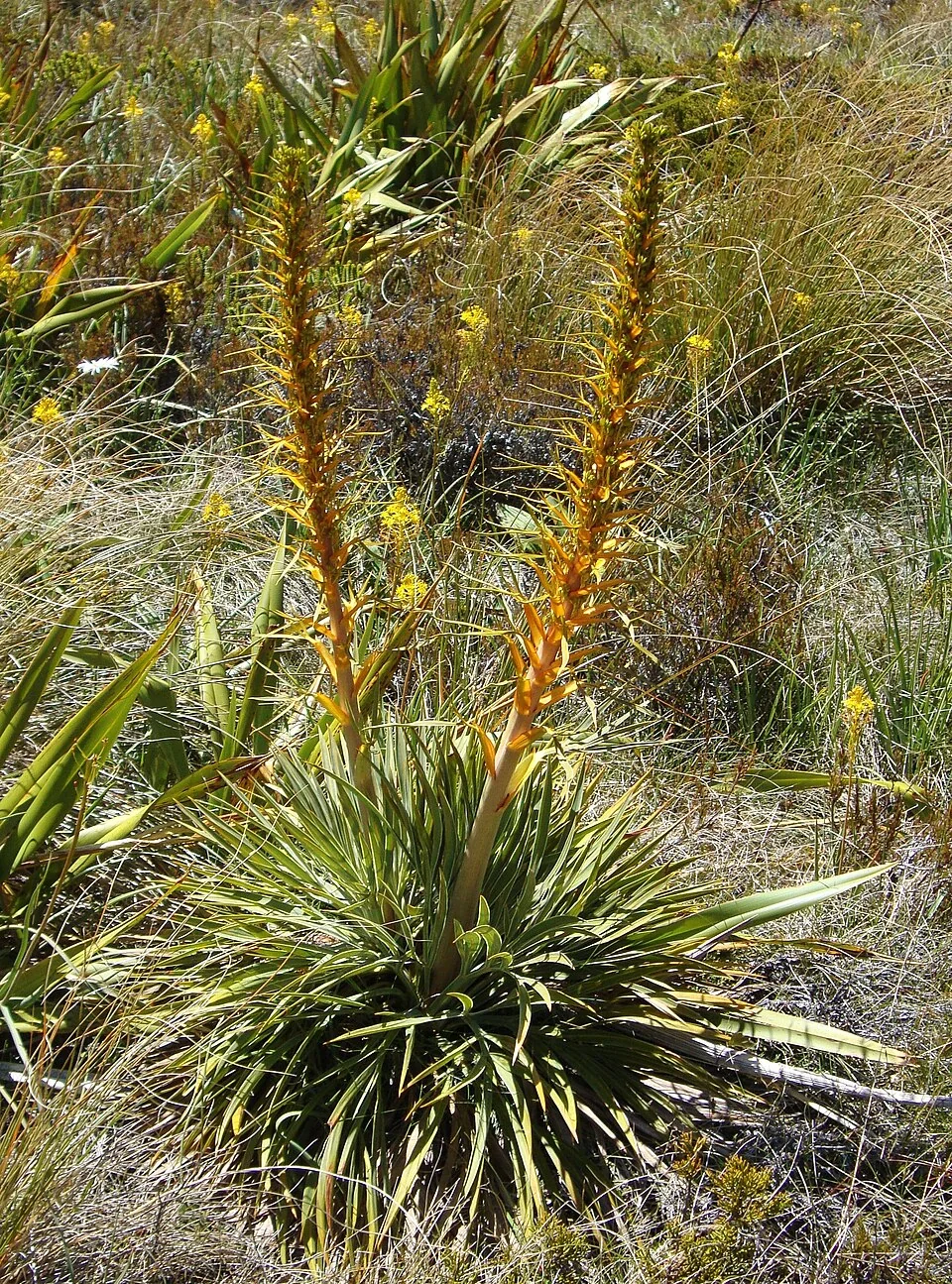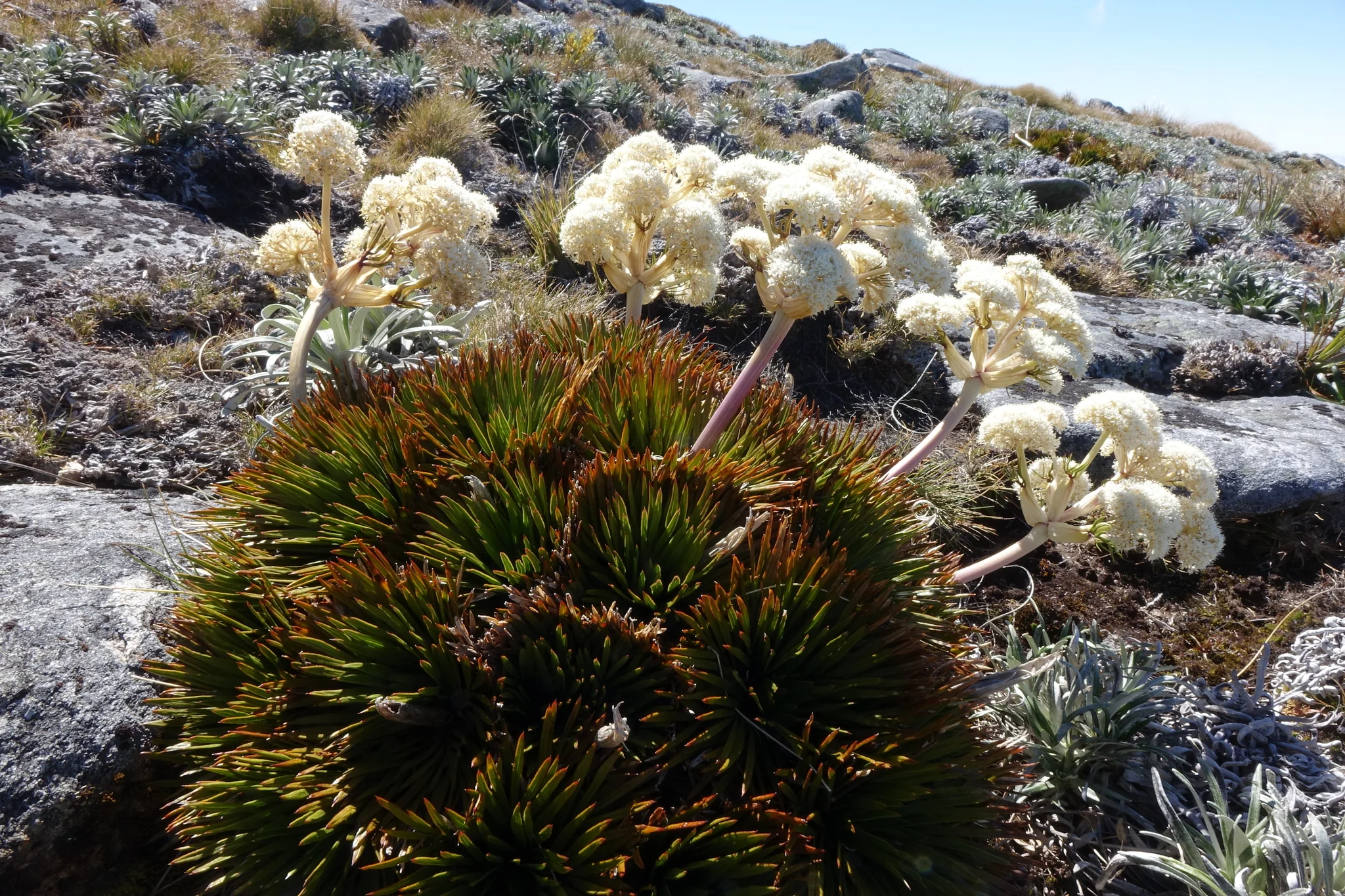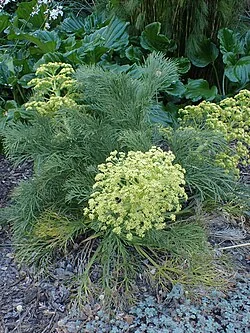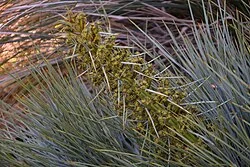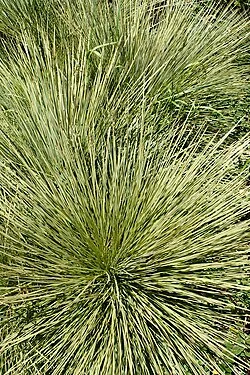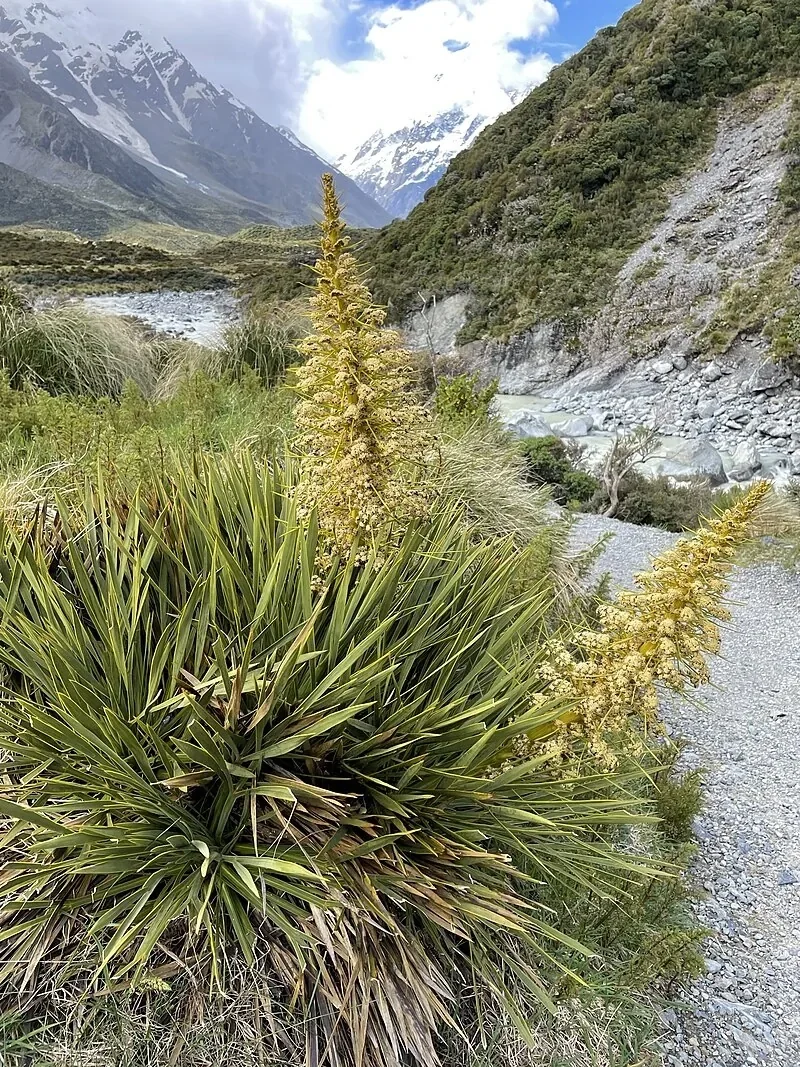
Golden Speargrass
Aciphylla aurea
Explore more NZ native plant guides in our index .
Introduction
Alpine Giant
Golden Speargrass ( Aciphylla aurea ) is a striking alpine plant renowned for its dramatic sword-like leaves and impressive stature. This hardy perennial forms large, architectural clumps with sharp-pointed golden-green foliage that creates a bold statement in mountain landscapes. As one of New Zealand's most distinctive alpine species, it demonstrates remarkable resilience to harsh weather conditions and serves as an iconic symbol of the country's high-country ecosystems.

Aciphylla aurea , commonly known as Golden Speargrass or Taramea, is a distinctive and formidable native plant of New Zealand's alpine and subalpine regions. It is a large, robust herbaceous perennial that forms dense tussocks of sharp, spiky leaves. The golden-yellow flower stalks, which can reach up to 2 meters in height, are a spectacular sight in summer. This plant is highly valued for its architectural form and resilience in harsh environments, making it a striking addition to rock gardens and alpine plantings.
Quick Facts
Essential Information
| Scientific Name | Aciphylla Aurea |
|---|---|
| Height | 1-2 m |
| Spread | 1-1.5 m |
| Water Needs | Low; very drought-tolerant |
| Light | Full sun |
| Frost Tolerance | Very high |
| Salt Tolerance | Low |
| Growth Rate | Slow |
| Lifespan | Long-lived perennial |
Climate Best Suited to
Aciphylla aurea is a plant of open, sunny, and well-drained sites in montane to subalpine grasslands and fellfields. It is most common in the drier mountains of the eastern South Island.
Regional Suitability
| City | Climate Suitability |
|---|---|
| Whangārei | Ideal |
| Auckland | Ideal |
| Hamilton | Ideal |
| Tauranga | Ideal |
| Rotorua | Ideal |
| Gisborne | Ideal |
| New Plymouth | Ideal |
| Napier | Ideal |
| Whanganui | Ideal |
| Palmerston North | Ideal |
| Wellington | Ideal |
| Nelson | Ideal |
| Christchurch | Ideal |
| Dunedin | Ideal |
| Invercargill | Ideal |
Natural Habitat
Typical Environments
Aciphylla aurea is endemic to the South Island of New Zealand, where it is a prominent feature of montane to low alpine landscapes.
- Geographical Distribution: Primarily found in the South Island of New Zealand, at altitudes ranging from 300 to 1,500 meters (approximately 1000 to 5000 feet) above sea level.
- Preferred Conditions: Thrives in dry, windswept grasslands, rocky outcrops, and tussock grasslands. It prefers well-drained, gritty, and low-fertility soils.
- Climate Tolerance: Highly tolerant of extreme weather conditions, including severe frosts (down to -17°C) and occasional fires. It prefers full sun but can adapt to part shade in areas with hot summers.
Plant Conservation
Status and Management
Golden speargrass ( Aciphylla aurea ) is a widespread montane-subalpine species of the eastern and central South Island and is currently regarded as Not Threatened at the national level. Local pressures include browsing by introduced mammals (hares, deer and occasionally sheep), trampling on popular alpine routes, and fires in dry uplands. The species persists well in rocky, open habitats and on protected conservation land, and readily maintains viable populations where browsing pressure is low. Excluding herbivores, avoiding unnecessary burning, and retaining intact tussock and herbfield communities are the most effective conservation measures. Cultivation in gardens and restoration projects also helps safeguard regional genetic diversity of this distinctive taramea.
Growing Requirements
Soil Requirements
Golden Speargrass thrives in well-drained, sandy, or gravelly soils that mimic its natural alpine habitat. Excellent drainage is essential as waterlogged conditions can quickly kill this plant. It prefers low-nutrient soils typical of alpine environments.
- Requires excellent drainage - sandy or gravelly soils ideal
- Tolerates poor, low-nutrient soils
- Avoid heavy clay or waterlogged conditions
- Suitable for rocky, exposed sites
- pH neutral to slightly alkaline preferred
Light Requirements
Aciphylla aurea requires full sun exposure to thrive. It has evolved in open alpine environments with intense sunlight and performs poorly in shaded conditions. Full sun also helps maintain the characteristic golden colouring.
- Full sun essential for optimal growth
- Tolerates intense alpine sunlight
- Poor performance in shade or partial shade
- Open, exposed positions preferred
- Sun exposure maintains golden colouring
Water Requirements
Once established, Golden Speargrass is extremely drought-tolerant and requires minimal watering. Water only during establishment and extended dry periods, ensuring the soil drains well to prevent root rot.
- Very drought-tolerant once established
- Water only during establishment phase
- Minimal water requirements in mature plants
- Avoid overwatering - can cause root rot
- Natural rainfall usually sufficient
Planting Guide
-
When to Plant
Plant in autumn or spring.
-
Site Preparation
Choose a sunny, very well-drained site.
-
Planting and Aftercare
Dig a hole twice the width of the pot. Add plenty of grit to the planting hole to improve drainage. Place the plant in the hole and backfill with soil. Water well.
Ecological Value
Ecosystem Roles
Aciphylla aurea , also known as golden spaniard or golden speargrass, plays several important ecological roles within its native New Zealand alpine and grassland ecosystems. As an evergreen, tussock-forming perennial, Aciphylla aurea contributes to the physical structure of dry, windswept grasslands and mountainous habitats, particularly on the east coast of New Zealand's South Island. It thrives in well-drained, often rocky soils, indicating a role in stabilizing these environments. The plant's distinctive stiff, sharp, and spiky leaves and flower bracts serve as a natural defense mechanism. This armature makes it deer-resistant and is hypothesized to have evolved to deter browsing by large herbivores, including the extinct giant moa. Aciphylla species are crucial to the survival of specific endemic insects. Notably, Aciphylla aurea provides a habitat for the critically endangered Canterbury Knobbed Weevil ( Hadramphus tuberculatus ), which is found only in the South Island of New Zealand. Due to its vulnerability to browsing when young, Aciphylla species, including A. aurea , have been proposed as indicators for assessing the impact of introduced herbivores like rabbits and hares on native plant communities. Studies have shown a significantly higher abundance of young A. aurea in areas protected from these animals. Aciphylla aurea is dioecious, meaning it has separate male and female plants. Its winged seeds are dispersed by wind, facilitating its spread and establishment within its preferred habitats.
Uses and Significance
Garden Uses
- A dramatic architectural plant for rock gardens, scree gardens, and dry, sunny borders.
- Its sharp leaves make it a good deterrent plant.
Landscaping Applications
Aciphylla aurea , or Golden Speargrass, is a striking plant highly valued in landscaping for its unique architectural form and resilience. Its bold, spiky, evergreen foliage provides dramatic structure and texture, making it an excellent accent plant in various garden designs.
Key Landscaping Uses:
- Architectural Feature: Creates a strong visual statement with its distinctive form and texture.
- Alpine and Rocky Plantings: Thrives in dry, exposed, and rocky conditions, making it perfect for alpine gardens, scree slopes, and rugged landscapes.
- Native Gardens: An ideal choice for New Zealand native plant gardens and ecological restoration projects.
- Borders and Edging: Can be used to define borders, though care should be taken due to its sharp foliage.
- Natural Barrier: Its sharp, spiny leaves act as an effective deterrent, useful for creating natural boundaries.
- Drought-Tolerant Gardens: Once established, it is extremely drought-tolerant, suiting xeriscaping and water-wise designs.
- Low-Maintenance: Requires minimal care, thriving in challenging conditions with little intervention.
- Deer-Resistant: Its spiky nature deters deer and other browsing animals.
- Wind-Tolerant: Well-adapted to exposed and windy sites.
- Seasonal Interest: Produces impressive golden flower spikes in summer, adding a vibrant seasonal display.
Considerations:
- Sharp Foliage: Due to its very sharp leaves, it is not recommended for planting near high-traffic areas like paths, sidewalks, or play areas.
Seasonal Care Calendar
Spring
Spring is when Golden Speargrass ( Aciphylla aurea ) begins its active growth period after winter dormancy. New shoots emerge from the base and this is an ideal time for planting new specimens. Monitor for any winter damage and remove dead foliage if necessary.
- Active growth period begins
- Ideal time for planting new specimens
- Remove any dead or damaged foliage
- Check drainage around established plants
Summer
Summer brings the spectacular flowering display of Golden Speargrass ( Aciphylla aurea ), with golden-yellow flower stalks reaching up to 2 meters high. This is the peak growing season, though watering should remain minimal due to the plant's extreme drought tolerance.
- Peak flowering season with golden flower spikes
- Main growing season
- Water sparingly, only during extreme drought
- Monitor for proper drainage
Autumn
During autumn, Golden Speargrass ( Aciphylla aurea ) begins to slow its growth as temperatures cool. This is another good time for planting as the cooler weather reduces stress. Seeds can be collected during this time for propagation.
- Growth slows as temperatures moderate
- Good time for planting new specimens
- Collect seeds for propagation
- Prepare plants for winter dormancy
Winter
Winter is the dormant period for Golden Speargrass ( Aciphylla aurea ). The plant is extremely cold-hardy and can tolerate severe frosts down to -17°C. No watering or special care is typically required during this season.
- Dormant period with minimal growth
- Extremely cold-hardy (tolerates -17°C)
- No watering required
- Plant rests until spring growth begins
Pruning and Maintenance
Techniques and Timing
Golden Speargrass ( Aciphylla aurea ) requires minimal pruning and maintenance due to its naturally compact growth habit and alpine adaptations. Care should be taken when working around this plant due to its sharp, spiky leaves.
- Remove dead, damaged, or brown leaves at the base in late winter/early spring
- Cut back old flower stalks after seeds have been collected or dispersed
- Wear thick gloves and protective clothing when pruning due to sharp leaves
- Avoid cutting into the central growing point
- Generally requires minimal intervention - let natural growth habit develop
- Remove any diseased or pest-damaged foliage promptly
- Prune selectively to maintain architectural form if needed
This plant's dramatic spiky form is its greatest asset, so pruning should be conservative and focus primarily on health maintenance rather than shaping. The sharp leaves provide natural protection from browsing animals.
How to Grow Golden Speargrass
Seeds
Seed propagation is the primary and most reliable method for growing Golden Speargrass, though it requires patience and specific techniques to achieve success. Seeds are typically winged schizocarps that are naturally dispersed by wind in their alpine habitat. For best results, sow seeds immediately upon receipt at any time of year, as they require several months in cold, damp conditions rather than dry storage. Fresh seeds can be collected in autumn when the flower heads mature and turn brown. The critical factor for success is cold stratification - either provide artificial cold treatment for 30 days or rely on natural winter conditioning. For artificial stratification, mix seeds with moist sand or peat moss and refrigerate at 4-5°C for 4-6 weeks, though some sources recommend up to several months for optimal results. Keep seed trays consistently moist in a cold greenhouse or shaded area throughout winter. Germination is typically slow and irregular, often taking 4-12 weeks or even until the following growing season, so patience is essential. Seeds may also benefit from a brief warm period before cold treatment to break initial dormancy. Maintain temperatures between 5-12°C for optimal germination and avoid exposing stratified seeds to sudden high temperatures.
Transplanting Seedlings
Once Golden Speargrass seedlings have germinated and developed their first true leaves, they require careful handling during transplanting due to their eventual size and sharp foliage. Young plants should be grown on in individual pots until they are robust enough for outdoor planting, typically when they reach 10-15cm in height. Choose a final planting location that receives full sun and has excellent drainage, as this alpine species cannot tolerate waterlogged conditions. The soil should be sandy or gravelly, mimicking their natural montane habitat, and low in nutrients as over-fertilization can lead to soft growth unsuitable for harsh conditions. When transplanting, space plants at least 50-70cm apart to accommodate their mature spread of 60-80cm and to showcase their distinctive architectural form. Plant at the same depth as in the container and water thoroughly to establish, but thereafter provide water only during extended dry periods as mature plants are highly drought tolerant. The best time for transplanting is spring or early autumn when temperatures are moderate and the plant can establish before extreme weather conditions.
Direct Sowing
Direct sowing of Golden Speargrass seeds in their intended growing location can be successful but requires ideal conditions and careful site preparation. This method is best suited to areas that naturally experience cold winters, as the seeds will undergo natural stratification. Prepare the site by ensuring excellent drainage and removing competing vegetation, as young Golden Speargrass seedlings are vulnerable to competition from weeds and faster-growing species. Sow seeds in autumn, pressing them lightly into a sandy or gravelly seed bed without covering deeply, as some light may aid germination. The soil should be moisture-retentive during winter but well-draining to prevent waterlogging. Mark the sowing area clearly as germination may not occur until the following spring or even later. This method requires minimal intervention but has lower success rates compared to controlled germination in pots. Protection from browsing animals may be necessary, as young seedlings are vulnerable until they develop their characteristic sharp foliage. Direct sowing works best in areas where conditions closely match the plant's natural alpine habitat, with cold winters, moderate summers, and excellent drainage year-round.
Pests and Diseases
Speargrass Weevil
While generally tough, Aciphylla species can be targeted by the native Speargrass Weevil (Lyperobius spp.), whose large larvae bore into the taproot, sometimes killing the plant. Watch for sudden collapse of the rosette.
Cultural Significance
Traditional Uses and Values
Golden Speargrass ( Aciphylla aurea ), known as Taramea to Māori, holds significant cultural value. The aromatic gum from the plant was traditionally used as a perfume and in various ceremonies. The sharp leaves were also used as a natural defense and in the construction of pā (fortified villages).
Bonus Tip
Interesting Facts
Did you know that the flower stalk of Aciphylla aurea can remain on the plant for up to two years after flowering? This means you can enjoy its impressive architectural form long after the golden-yellow flowers have faded.

